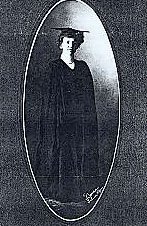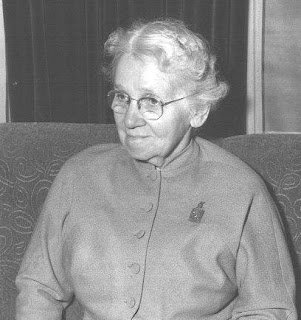More than a half century later, Mary Purvine remembered the moment in 1898 when she decided to be a doctor: “A woman physician was called when a fall on a slippery board caused a fracture of mother’s right arm. Since at that time I had never seen or scarcely heard of a woman doctor, I can still feel the thrill of watching her deft manipulation reduce the dislocated bones and put in a splint. After watching this process and the dressing, I announced to the surprised family that I was going to be a doctor. No one seemed shocked; Mother suggested that I would have to take Latin if I were to take up medicine – and so the die was cast.”
Mary was the youngest daughter of Daniel and Lydia (Battey) Bowerman, a farm family in Hesper, Iowa. Mary was born there in 1881 and, at the age of 17, accompanied her parents and three older siblings on their move to Oregon. Settling on 26 acres near Rickey, Mr. Bowerman engaged in farming, despite a chronic heart condition; his condition was “a shadow that never lifted”, according to Mary.
By the time Mary had enrolled at Willamette, her eldest brother had been killed “driving in front of a passenger train”, the next brother was on the way toward a legal career, her sister becoming a teacher. Mary said that at that time, she was a “tow-headed girl with non-descript features, thin and straight, who knew nothing of the world except that one worked for a living, that it was a sin to tell a lie, and the worst thing in the world was to be a drunkard.”
This young lady was sent off with a further admonition from her mother: “As I was supposed to go to medical college later, the idea was supposed to be firmly in my mind that I was never to marry, consequently never to have a boyfriend.”
Romance was not part of Mary’s Willamette experience. Being the lone female in a class of five was a terrible experience as she was the butt of their “rather vulgar jokes”. One of the stories she recalled for the collection of anecdotes her daughter published in 1958 concerned the dissecting shed down near the millrace at the rear of the university grounds. As it was a “short cut” path through the campus to town and featured many a knothole in its walls, there was often an audience to observe the gloveless, collidion-dosed, black muslin-gowned students, surgical instruments in hand, making tentative incisions on the cadavers.
In 1903, with medical license in hand, Mary moved to Condon as her brother Jay had his legal practice there. After four years in eastern Oregon dealing with primitive conditions and a prevailing prejudice against female doctors, she returned to Salem as Mrs. Ellis Purvine and began a medical practice specializing in obstetrics. She also began a family: two daughters and a son who became a doctor himself.
Through the years she was active in the First Congregational Church, the Salvation Army, Salem Business and Professional Women’s Club, and served on the staffs of both Salem General and Memorial Hospitals. In 1954, to commemorate her half-century in the medical profession, she was recognized by the University of Oregon Medical School Alumni Association for her 50 years “of service and sacrifice to the alleviation of human suffering.”
She retired in 1962 still endowed with a lively sense of humor as her stories of her early experiences as a doctor, published by her daughter, clearly show. Her long life of service ended in 1965 when, on June 10th, she passed away peacefully at her home on University Street. She was buried at City View next to her husband.
This information from:
“How I Became A Woman Doctor,” by Mary Purvine. From her book Pioneer Doctor, excerpted in Marion County History, Volume V, June 1959, and her obituary, Oregon Statesman, June 11, 1965, Section II, Page 31.


